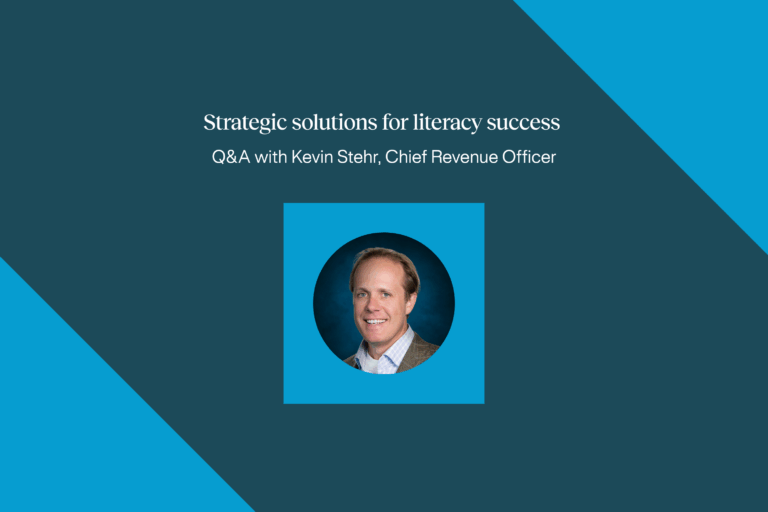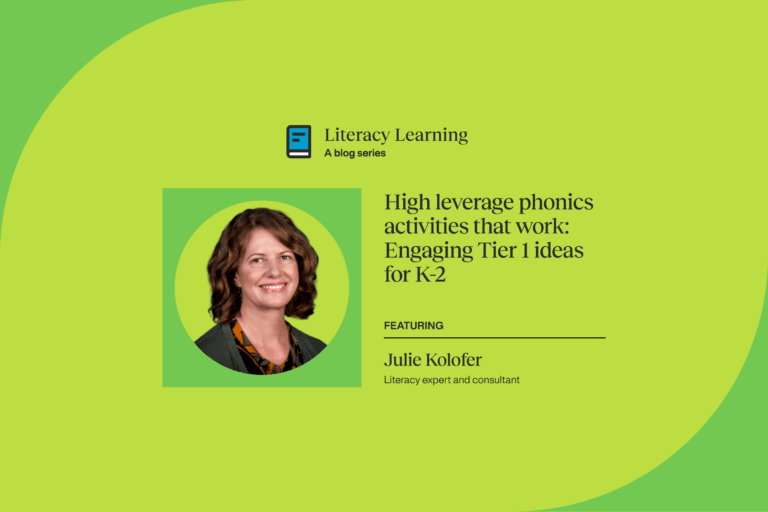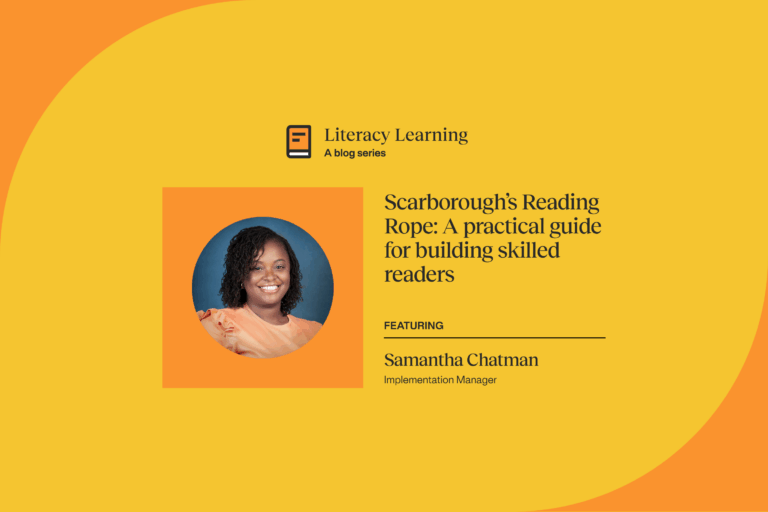The stages of literacy development: A complete guide

While the term “stages of literacy development” is a commonly used and searched-for phrase, literacy learning is actually a fluid process, making “phases of literacy” a more accurate way to describe this process. We rely on the work that Linnea Ehri, PhD, Educational Psychologist and expert on the development of reading, has done in identifying and evaluating what literacy development looks like at each phase (Beech, 2005).
Laura Stewart, Chief Academic Officer for 95 Percent Group offers the following explanation. “Linnea Ehri’s work is very particular about the use of the term phases: they are sequential and build upon each other, sometimes overlapping and recursive, but representing the overall progression of development. Stages implies something we pass through on our way to something else, never to return.”
Ehri’s work offers a flexible framework within which to understand how children move through the different phases as they are developing early foundational skills even as they do so within a developmentally “normal” range. This is different from stating that all children should be able to do something by a specific age or stage.
What is literacy development?
Literacy development refers to the path necessary for all to learn to read.
While there is a definitive path that children follow in order to reach proficiency in reading and writing, the fact is that they may not all develop through each phase at the same rate, and there will be children that perhaps need to move more fluidly between phases in order to ensure they have mastered important foundational skills.
The body of research known as the science of reading has provided insight into understanding what components are needed and the way in which we must deliver them in order for all children to have the opportunity to read proficiently.
Why is literacy development important?
In an educational climate where there has been little progress made in ensuring that all children learn how to read, and where in fact, statistics in 2022 showed that reading scores were on the decline compared to both 3 years ago and almost 30 years ago, there is nothing more urgent than understanding how children develop literacy skills.
As more and more educators are learning about and receiving training in the science of reading, it’s critical that every teacher of reading has a depth of understanding about the way in which children develop the same set of skills.
Let’s take a closer look.
Five phases of literacy development
In 1995, after years of her own research on how children learn to read, Linnea Ehri, PhD, published her findings on what the different phases of literacy development look like. Although there are discrepancies on exactly when each child will be definitively done with a phase, we now know that the path each of them takes is the same.
Here we offer an overview of the 5 phases of literacy development along with an average age/grade children will be when accessing these skills.
*Age ranges are simply a framework; all children develop literacy skills at a slightly different pace.*
Pre-Alphabetic
Age range: Pre-k
Children in the first phase, as the name suggests, do not have any alphabetic knowledge—or knowledge of phoneme-grapheme connection. This means if a child seems to recognize a word or phrase it is because it’s accompanied by a “cue”: the shape of the word, or more often a logo or picture, a visual graphic. If the word were to have letters swapped out from the middle, the child likely wouldn’t notice in this phase.
A great example of this might be a child beginning to recognize things like a stop sign based on their color and shape, or their favorite brands based on the logo, but wouldn’t recognize the same words out of that context.
Please remember this does not represent all children. There will be plenty of children who have exposure to these concepts before they go to school and some even who are reading by or before kindergarten. Likewise, there will be children that stay in the pre-alphabetic phase well through kindergarten or beyond.
Partial Alphabetic
Kindergarten/End of kindergarten
As children near the end of kindergarten, many or most will know all or nearly all of the letters of the alphabet—both upper and lower case. While typically children in kindergarten will have received at least some phonemic awareness and decoding instruction, the rate at which they master these skills differs.
Ehri calls this the partial alphabetic phase because most children can have some recognition of sounds as they connect to a grapheme and can use what they know to attempt pronunciation of the word. Ehri coined the phrase, “phonetic cue reading,” and her research has shown that readers in this phase most commonly use the first and last sounds in a word to help them decipher what it says. She also offers that visual presentation of words can play a role in whether children in this phase can recognize the word (Beech, 2005). Children in this phase typically cannot yet systematically decode words.
Full Alphabetic
By or around the end of 1st grade, children are much more adept at decoding and have a greater ability to sound out one-syllable, phonetically regular words. Typically, readers in this phase recognize closed syllable words (cat, man, mom), silent e words (like, bake, home), open syllable words (hi, by, me), r-controlled vowel words (car, her, for), and words that have vowel combinations (zoom, tree, may).
Although their capacity for automaticity is increasing, most are still depending on sound/symbol recognition for sounding words out. In the full alphabetic phase, children still misspell words, however, their errors do not render the words unreadable, as they are now able to account for most sounds—even if the spelling patterns aren’t correct. Additionally, most children still have a much higher oral language comprehension than reading comprehension.
Consolidated Alphabetic
As you may have noticed by now, children that progress typically in their reading skills tend to move through about one phase per year of school. Please remember that while this is a convenient way to organize and understand the way children develop literacy skills, it’s definitely not true for every child.
By the end of 2nd grade, many typically developing readers who have had consistent instruction, are considered to be in the consolidated alphabetic phase. This means that they are moving toward being able to automatically decode familiar words, including those that end in consonant-le (fickle, sparkle, bubble) and including phonetically regular two-syllable words (byline, tripod, starfish).
Typically developing readers in this phase are consolidating known spelling patterns and are thus more easily and quickly able to decode words. This increase in fluency also translates to writing: where most students are spelling more words correctly.
Automatic
In 3rd and 4th grade and beyond, typical readers are now considered to be in the automatic phase. Ehri describes readers in this phase as no longer needing to decode familiar or unfamiliar words sound-by-sound (excepting words, for example, that are of foreign derivation like “rendezvous”). Because automatic phase readers no longer need as much cognitive capacity for decoding, they have a greater ability to and more working memory available for comprehending what they read. Word reading becomes less of a limiting factor in comprehension than, for example, background knowledge or knowledge of vocabulary.
As the vocabulary and content demands become significantly greater as students enter 3rd and 4th grade and beyond, intentional instruction in morphology and vocabulary development is extremely important. A depth of understanding of and practice with reading and spelling morphemes can significantly impact reading and writing outcomes.
Individual differences and supporting all learners
As stated multiple times throughout, the learning trajectory of each student can differ. While a “typically” developing child will fall mostly within the bounds of these phases, many will not.
One of the most important ways to ensure that all students are getting the best possible literacy instruction is assessment. With a diagnostic assessment and frequent progress monitoring, teachers can better understand which skills their students have mastered and which they still need to work on.
Research has told us that by implementing aligned literacy resources, based in the science of reading, it’s possible that 95% or more of students can learn to read.
Strategies for supporting all learners
While all children should receive core literacy instruction in their classroom daily, there will be those that need more intensive support. When you have assessed your students and understand their needs, it’s possible to offer an accelerated learning model which means they will receive intervention support in addition to their core literacy instruction.
Having instruction and practice above and beyond what they are already doing in their classroom, is one way of helping students to close the foundational skill gaps they may have in order to help them quickly move closer to grade level reading.
Conclusion
Even though we know that students develop at different rates and do not move through phases of literacy instruction in lock step with one another, it is entirely possible to have the resources and knowledge you need to ensure that all students are receiving the literacy instruction necessary to unlocking this foundational lifelong skill.
Looking for more information? Check out what’s happening in your community or contact a literacy specialist today!
Resources
- Beech, John. (2005). Ehri’s model of phases of learning to read: A brief critique. Journal of Research in Reading. 28. 50 – 58. 10.1111/j.1467-9817.2005.00252.x.
- Typical Reading Development | Reading Rockets. (n.d.). Reading Rockets. https://www.readingrockets.org/reading-101/how-children-learn-read/typical-reading-development



